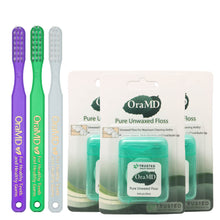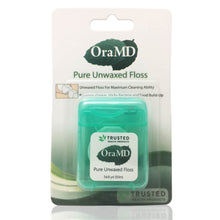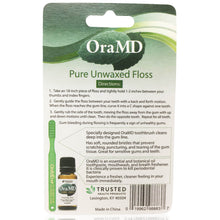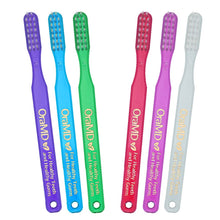OraMD Dr. Bass Toothbrush - 3 Pack, OraMD Pure Unwaxed Dental Floss - 3 Pack
by Trusted Health Products
Precio habitual
$19.97
Oferta
What you need to know about our product
* COLORS ARE CHOSEN AT RANDOM
Dr. Charles C. Bass, a medical doctor and dean of Tulane University School of Medicine spent 20 years of his life researching and developing the optimal oral hygiene method. His legacy is a revolutionary designed toothbrush and brushing technique. When Dr. Bass died at 100 years of age he had all his teeth.
The Dr. Bass toothbrush has 3 rows of bristles, 6 tufts to a row, evenly spaced. This toothbrush design allows the bristles to enter the gum line crevice to remove foreign particles, bacteria, plaque thereby reducing cavities and preventing gum infection. The body is made of a polypropionate substance which is biodegradable.
The bristle length is 13/32 of an inch long and .007 inches in diameter. This allows the bristle to bend effectively and penetrate deeper into the pits, grooves, depressions and narrow spaces on and in between the teeth.
The soft nylon bristle is rounded at the top and not cut across the top like other toothbrushes. This prevents scratching, puncturing, and tearing of the gum tissue and scraping of the tooth enamel when vigorously brushing. This toothbrush will not harm the soft gum tissue or push it away from the roots. If bleeding persists it could be a sign of gum problems.
Colors chosen at random.
FLOSS
For optimal oral care, be sure to floss once per day with our OraMD pure unwaxed, unscented, chemical free nylon floss.
Effectively removes plaque, food and foreign particles between teeth and just below the gum line
Satin like texture, shred and break resistant
Ideal for sensitive gums
Slides easily in tight spaces, unwaxed floss is thinner
Sure grip
54.6 yards of floss
Vegan, paraben-free, cruelty-free
No chemical or synthetic fragrances
No chemical waxes (floss wax is 20% paraffin wax and 80% petroleum chemical wax)
No chemical PFA’s or Teflon-like substances that contain PFC’s (used to manufacture and coat floss) One study found that women who flossed with Oral-B Glide floss had higher levels of a chemical called perfluorohexane sulfonic acid (PFHxS) in their blood than women who didn’t use that type of floss. These chemicals have been linked to liver damage, harm to the immune system, developmental issues, cancer, and can persist in people’s bodies and in the environment for many years.
The wax used in conventional floss is 20% paraffin wax (bee’s wax) and
80% microcrystalline which is a chemical wax that comes from the petroleum industry. Microcrystalline waxes are derived from the refining of the heavy distillates from lubricant oil production. This by-product must then be de-oiled at a wax refinery, and then have its odor and color removed by hydro-treating the wax material.
Flossing can improve the health of your gums and is an important oral hygiene practice.
Flossing does about 40% of the work required to remove sticky bacteria, or plaque, from your teeth. Most plaque hardens within 48 hours of formation, and within several days it will become so hard that it is almost impossible to remove. Tooth decay and serious gum problems can develop when plaque is allowed to build up on teeth and along the gum line.
The places where the gums and teeth meet are where flossing plays its major role. Tiny particles of food can get lodged here, and plaque in this area will harden and accumulate over time to form tartar, a thick deposit that only the dentist can remove with a scraper. Tartar buildup can lead to gingivitis: red, swollen gums that are the first stage of gum disease. If left unchecked, the bacteria-laden tartar and plaque can spread even deeper below the gum line, causing periodontitis: severe gum disease characterized by severe inflammation and eventual tooth and bone loss.
Brushing technique: Hold the OraMD toothbrush at a 45-degree angle to your teeth and brush in a short, circular motion with the bristles penetrating the gum line as you brush. Apply firm but light pressure. This gentle sweeping action along the gum line will dislodge the soft material containing foreign particles, bacteria and plaque thereby reducing cavities and preventing gum infection. Brush the outer surfaces, the inside surfaces, and the chewing surfaces of all teeth. Brushing application: Wet toothbrush, turn bottle upside down, drop 1-5 drops (1-2 starting) of OraMD onto the bristles and brush as directed. Those who have sensitive gums should increase the amount at their own pace. Be sure to brush your tongue. Stay within your comfort zone. This specially designed toothbrush works optimally with OraMD. However, if using regular toothpaste apply as directed. You may experience slight bleeding for the first couple days as the OraMD toothbrush and brushing technique penetrates and cleans the gingival crevices. If bleeding persists, it could be a sign of serious gum problems.
Floss
Floss once a day preferably before bedtime and before brushing.
-
Take an 18-inch piece of floss and tightly hold 1-2 inches between your thumbs and index fingers.
-
Gently guide the floss between your teeth with a back and forth motion. When the floss reaches the gum line, curve it into a C shape against one tooth.
-
Gently rub the side of the tooth, moving the floss away from the gum with up and down motions until clean. Avoid sawing motions with the floss – that can hurt your gums. Then do the opposite tooth. Repeat for all teeth.





